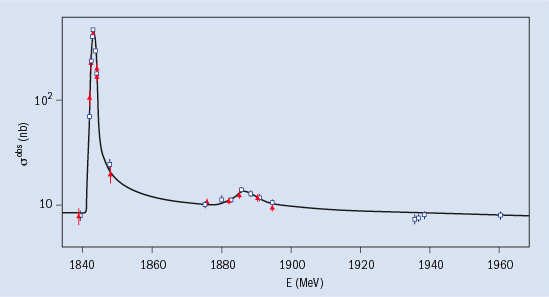In October 2005 the VEPP-4M collider at the Budker Institute of Nuclear Physics started its latest run with the KEDR detector. This continues a series of experiments that are exploiting the method of resonant depolarization (which was proposed and developed at the Budker Institute) to make precise measurements of masses in the region of the Ψ to Υ mesons (Skrinsky and Shatunov 1989).
Progress in understanding the resonant depolarization technique, as well as a new detection system for Touschek electron pairs (intrabeam scattering), has resulted in a significant improvement in the accuracy of the beam energy determination with KEDR. The error in a single measurement of the beam energy has reached a level of 1 keV, corresponding to a relative accuracy of 0.7 ppm. Figure 1, for example, illustrates a very clear jump in the counting rate of Touschek pairs, allowing a precise measurement of the depolarization frequency directly related to the beam energy. In 2002 this led to a measurement of the mass of the J/Ψ with a relative accuracy of 4 ppm: MJ/Ψ = 3096.917 ± 0.010 ± 0.007 MeV (Aulchenko et al. 2003). Compared with the previous experiment in 1980, this represented a sevenfold decrease in the uncertainty in the mass.

In 2004 the masses of the Ψ’ and Ψ(3770) were measured in a second run in KEDR. The results, which are shown in figure 2, were presented recently at the HEP2005 conference in Lisbon in July. The preliminary values of the masses of the Ψ’ and Ψ(3770) are 3686.117 ± 0.012 ±0.015 MeV and 3773.5 ± 0.9 ± 0.6 MeV, respectively.
The precise measurement of the masses of the J/Ψ and Ψ’ mesons provides a mass scale in the energy region around 3 GeV, which forms the basis for an accurate determination of the mass for all charmed particles and the τ lepton. Since the width of the τ is proportional to its mass to the fifth power, high-precision tests of the Standard Model are very sensitive to the accuracy of this mass. At present the accuracy of the τ’s mass is dominated by the accuracy of the measurement by the Beijing Spectrometer (Bai et al. 1996).

KEDR began the measurement of the mass of the τ in spring 2005. Using the same method as the Beijing Spectrometer, the collaboration plans to determine the mass by measuring the energy dependence of the cross-section near threshold. The aim is also to improve the statistics of τ decays, benefiting from the precise knowledge of the beam energy. In KEDR the energy is measured by two methods: resonant depolarization for a high-accuracy measurement once a day, and Compton backward scattering for monitoring the beam energy drift during data collection. Data processing is currently in progress.
Further reading
V M Aulchenko et al. 2003 Phys. Lett. B 573 63.
J Z Bai et al. 1996 Phys. Rev. D 53 20.
A N Skrinsky and Yu M Shatunov 1989 Sov. Phys. Usp. 32 548.





